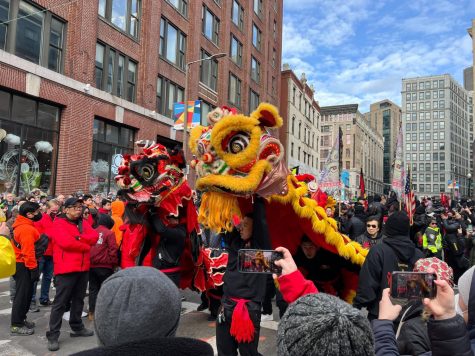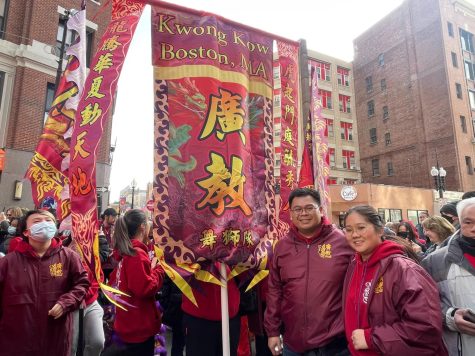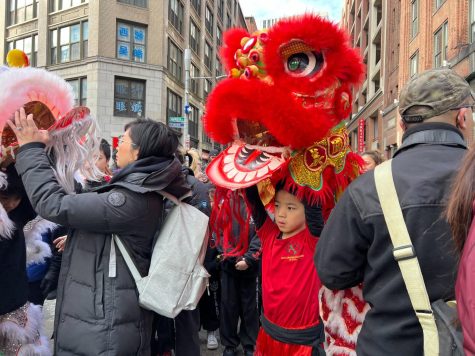Colorful lion dancers, clanging cymbals, and authentic food filled the streets of Chinatown on Sunday as thousands gathered to celebrate the Lunar New Year.
The city’s annual Chinese New Year parade kicked off with a procession of eight local lion dance groups toward Phillips Square to ring in the Year of the Rabbit and bid farewell to the Year of the Tiger.
“[The Chinese community] is important far beyond the city of Boston and is a hub for our culture across the whole New England region,” Boston Mayor Michelle Wu said in her address.
The crowd gathered to witness a number of Lunar New Year customs, including the traditional lion dance, in which two dancers don a lion costume, each one adorned in a variety of colors. One performer becomes the head and front limbs of the lion as the other crouches behind as the body and hind legs. Together, the performers imitate a lion dancing to the accompanying rhythm of clanging cymbals, beating drums, and resounding gongs.

Lion dancers in the parade donned costumes of a variety of colors.
After processing to the square—which is at the intersection of Harrison Avenue and Beach Street—the lion dancing troupes dispersed throughout the neighborhood, stopping at each Chinatown business to bless them with good luck and the popping of firecrackers to ward off bad spirits.
The troupes also performed the traditional “plucking of the greens” practice, or Cai Qing, during which the lion “eats” a head of lettuce and a red envelope containing money before spitting out the lettuce. This performance symbolizes good fortune and prosperity for the new year.
Among the organizations involved was the Kwong Kow Chinese School, a program that works with students outside of their own schools to provide additional cultural and academic support. The school works to preserve the Chinese culture and language while aiding first generation immigrant students and other members of the community. Kwong Kow was founded in 1916 and continues to act as a pillar of success for Chinatown residents.
At the parade, students from Kwong Kow showcased their work from their after-school lion dance program.
“Our youth team is only a little bit over a year old and this year is the second time we have been in the parade,” Bi Huang, a Kwong Kow administrator, said in an interview with The Beacon.

Bi Huang, right, is an administrator for Kwong Kow Chinese School.
The school’s lion dance team started with 20 students and has now grown to 40, she said.
“It’s really important for the kids to connect to the community and stay off the streets,” Huang said. “This year we are so proud.”
First-year creative writing major Katie Koenig attended the parade Sunday afternoon. Having grown up an hour outside of San Francisco, whose Chinatown is the largest outside of Asia and the oldest in the U.S., Koenig said she had heard about Chinese New Year celebrations in the city but never attended any.
“I [had] to see it,” Koenig said, now living in a closer proximity to a major city’s Chinatown. “It’s really cool. I’m definitely glad I came.”
Koenig’s favorite part of the parade was the lion costumes.
“[The costumes] all look amazingly intricate and absolutely gorgeous,” she said. “It’s really neat to clearly see all of the effort and coordination that went into planning something like this, and it turned out great.”

A young lion dancer supports the head of his costume.
Leanna Dang, a banker from Sharon, attends the parade with her family each year. She and her daughter, Lauren, a first-year at Sharon High School, also enjoyed watching the lion dancing on Harrison Avenue Sunday morning.
“It’s just a tradition, as Americans as well, that we celebrate the new year,” Dang said. “Bringing luck, wealth, prosperity, everything, [and] just coming out to enjoy the fun.”
Dang said this year’s parade was more enjoyable than some previous years when the weather had impeded the celebrations.
“It’s a beautiful day today,” she said. “Most of the time, it’s either snowy, cold, rainy, or miserable, so this is great.”
When she was younger, Dang’s favorite part of Lunar New Year was receiving traditional red envelopes containing money. Now, as a parent who gives her own children red envelopes each year, her appreciation for the celebration has expanded.
“I think the excitement is everybody coming together as one and celebrating a new year, [with] the excitement and loud noises, and everybody coming out, especially after COVID,” Dang said. “It’s just nice to get everyone together—mixed cultures, diversity, [and] everybody standing together.”